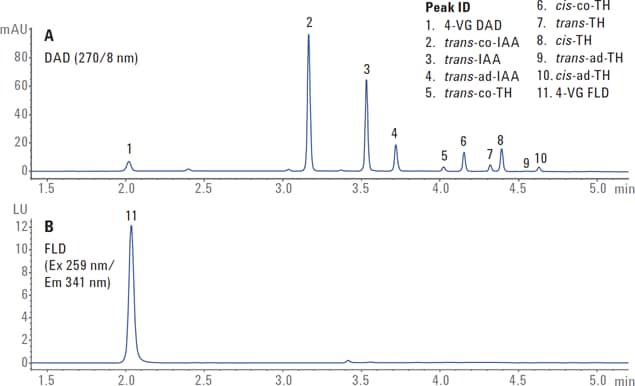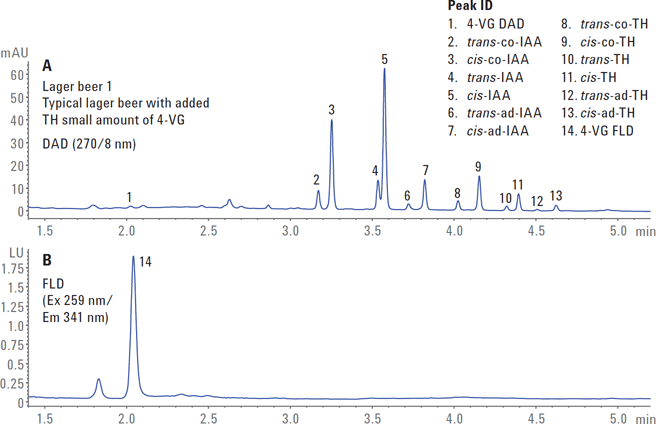Access Agilent eNewsletter September 2016

Fast determination of bitter, clove-like flavor in beer with the Agilent 1290 Infinity II LC
Gerd Vanhoenacker, Mieke Steenbeke,
Frank David, and Pat Sandra
Research Institute for Chromatography, Belgium
Udo Huber
Agilent LC Application Manager
A wide variety of chemical compounds contribute to the flavor of a good beer. While beer flavor is complex, the Agilent 1290 Infinity II LC System is an ideal instrument to determine the bitter compounds and the clove-like phenolic flavor 4-vinylguaiacol in bottled beer. This article describes a six-minute UHPLC method that measures these important solutes in a single run. Diode array and fluorescence detectors (DAD and FLD) placed in-series enable quantification of all these compounds. The fluorescence detector provides a selective, sensitive, and accurate determination of ppb amounts of 4-vinylguaiacol.
Beer quality control requires good chemistry
Hops (Humulus lupulus L.) or hop extracts contain alpha-acids or humulones, and are added to the boiling wort during beer brewing to impart a bitter flavor. The nearly tasteless humulones are converted into the bitter-tasting iso alpha-acids (IAAs) or isohumulones in the boiling process. Foam and light-stability of beers are often improved by the addition of reduced IAAs such as tetrahydroiso-alpha-acids (tetrahydroisohumulones, THs).
Another important flavor compound found in some beers is 4-vinylguaiacol (4-VG). 4-VG is responsible for a clove-like or phenolic flavor. While wheat and some other special beers contain significant amounts of 4-VG, most beers contain only trace levels of this compound (in the 0.05 to 0.25 ppm range). However, the flavor threshold of 4-VG is relatively low (about 0.1 to 0.2 ppm), so you need a sensitive and robust method to quantify trace amounts of 4-VG.
Accurate determination of IAAs, THs, and 4-VG is of utmost importance for beer quality control. This article describes a fast and sensitive UHPLC method for the analysis of all these compounds in bottled beers. It requires only a single run on the Agilent 1290 Infinity II LC System using DAD and FLD in series.
Eliminate the sample preparation and still get excellent quantitative data
A primary goal of the study was to develop a method for simultaneous analysis of the bitter acids and 4-VG without any sample preparation, by direct injection of degassed beer. The most challenging part of this analysis was the determination of 4-VG at sub ppm levels in the complex beer matrix. A gradient method with an isocratic hold at the beginning of the run was then developed. The isocratic part reduced risk of 4-VG interference from neighboring peaks. We used the gradient after the elution of 4-VG to sharpen the peaks of the IAAs and tetrahydroisohumulones (THIAAs) and to reduce analysis time. 4-VG was detected with DAD and FLD; the IAAs and reduced IAAs required DAD only.

Figure 1. Good separation of a standard solution that contained about 1 ppm 4-VG, 20 ppm IAAs, and 5 ppm THs.

Figure 2. Analysis of typical pilsner-type beer reveals a small amount (0.12 ppm) of 4-VG.
Figure 1 compares DAD and FLD signals for a standard solution. Note that the IAA standard contained only trans-IAAs, while the beer sample contained both cis- and trans IAAs. Our analytical conditions separated cis- and trans IAAs and reduced cis- and trans-IAAs, which enabled the quantification of each important bitter solute.
The standard solution was injected six consecutive times to determine the repeatability of injection, and area relative standard deviations were all less than 1 percent. Using a nine-level calibration, the correlation coefficients were better than 0.999 for all individual compounds.
Detect and quantify the important low-level flavor component
Beer samples were degassed by sonication and filtered with a syringe filter prior to analysis. Figure 2 shows the chromatogram for a typical Belgian lager beer that contained all the bitter acids discussed above, together with a small amount of 4-VG (0.118 ppm). It is clear that detection and quantitation of this compound is difficult with DAD because of the low signal intensity and presence of adjacent peaks. But with fluorescence detection at the appropriate wavelength settings, 4-VG is easily detected and accurately quantified in real beer samples.
To demonstrate the applicability of the method, 14 various types of beer were analyzed for 4-VG, IAAs, and THs. Agilent publication 5991-6665EN summarizes the quantitative data together with ratios for the various acids. It also show the chromatograms for a number of selected beers.
Rapid analysis delivers the required results
The developed method minimizes sample preparation and enables the fast and accurate determination of IAAs, THIAAs, and 4-VG in beers. While DAD is appropriate for most beer components, the FLD provides better sensitivity for 4-VG and enables quantification at the threshold value of this important flavor compound. The Agilent 1290 Infinity II LC System was successfully used to quantify the compounds in a selection of beers, which demonstrates the applicability of the method.
Whether you work in the brewing industry or are an interested home-brewer, read this blog and explore the wide range of solutions that Agilent offers for beer analysis. At the bottom of the page find links to helpful Agilent publications about beer analysis. Then contact your Agilent representative for more information on Agilent solutions for quality control of beer.
Stay informed about the applications that are important to you
Subscribe to Access Agilent
Our free customized
monthly eNewsletter
Article Directory – September 2016
All articles in this issue
 High-resolution, efficient quantification of aggregates in protein therapeutics with Agilent 1290 Infinity II 2D-LC Solution
High-resolution, efficient quantification of aggregates in protein therapeutics with Agilent 1290 Infinity II 2D-LC Solution Fast determination of bitter, clove-like flavor in beer with the Agilent 1290 Infinity II LC
Fast determination of bitter, clove-like flavor in beer with the Agilent 1290 Infinity II LC Direct heating delivers a new paradigm in gas chromatography analysis
Direct heating delivers a new paradigm in gas chromatography analysis Implementing an extractable and leachable (E&L) study from a pharmaceutical product by high resolution QTOF LC-MS
Implementing an extractable and leachable (E&L) study from a pharmaceutical product by high resolution QTOF LC-MS Multi-omic analysis helps researchers to integrate complex omics data in cancer research
Multi-omic analysis helps researchers to integrate complex omics data in cancer research Gain control—Agilent 490-PRO Micro GC optimizes process monitoring
Gain control—Agilent 490-PRO Micro GC optimizes process monitoring
Figure 1

Good separation of a standard solution that contained about 1 ppm 4-VG, 20 ppm IAAs, and 5 ppm THs.
Figure 2

Analysis of typical pilsner-type beer reveals a small amount (0.12 ppm) of 4-VG.